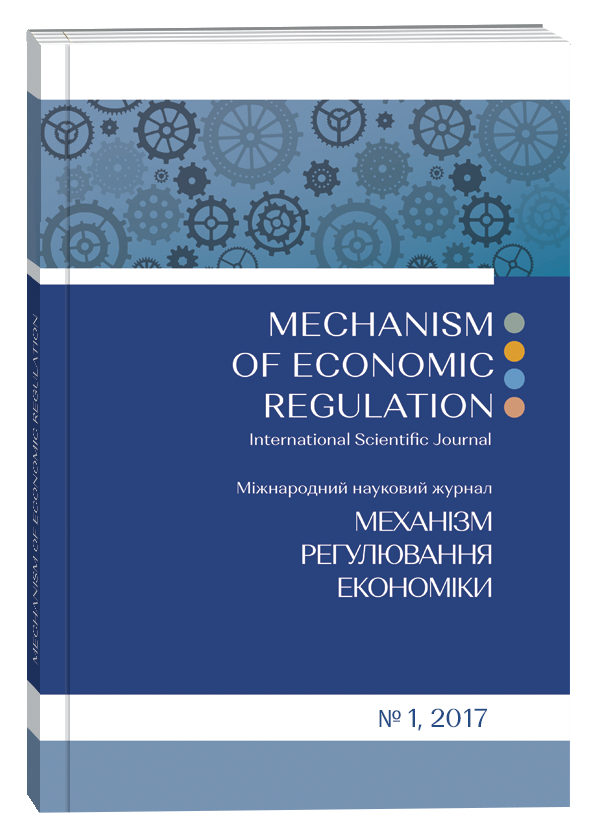ДОДАНА ВАРТІСТЬ, ЯК КРИТЕРІЙ ЕФЕКТИВНОСТІ ГЛОБАЛЬНИХ ЛАНЦЮГІВ ВИРОБНИЦТВА
Анотація
У світовій економіці останні роки простежується зростання валового експорту по відношенню до обсягу виробництва, який в певній мірі можна пояснити більш інтенсивним використанням глобальних ланцюжків доданої вартості: зростає число проміжних ресурсів, що вводяться, які перевозяться з однієї країни в іншу в рамках виробничого процесу. У статті розглянуті існуючі підходи до визначення доданої вартості, що формується у глобальних ланцюжках виробництва. Обґрунтовано, що такий аналіз дозволяє визначити, де формується найбільша додана вартість, а також сформувати можливі напрями розвитку діючих елементів ланцюжка. Виділено, що компанія або країна повинні прагнути до присутності в тих ділянках глобальних ланцюжків, де генерується більш висока додана вартість. Але крім вбудовування в існуючі ланцюжки важлива й власна промислова політика країни, яка в цілому призводить до структурних зрушень в промисловості.
Посилання
Guide to Measuring Global Production UNECE, 2015 [Electronic resource]. – Accessed mode : http://www.unece.org/fileadmin/DAM/stats/publications/2015/Guide_to_Measuring_Global_Product ion 2015_.pdf.
Balbeko, M. Metodolohyya otsenky byznesa na osnove kontseptsii intellektualʹnogo kapytala / A. M. Balbeko, R. P. Bulyha, P. A. Kokhno // Sotsyalʹno-humanytarnye znanyya. – 2008. – № 2.– P. 195–208.
Aichele, R. Trade and free trade agreement formation revisited: A trade in value added perspective [Electronic resource]/ R. Aichele, G. Felbermayr and I. Heiland. Munich, Germany.– Accessedmode :http://www.etsg.org/ETSG2013/Papers/147.pdf. P. 10.
Baldwin, R. Gravity chains: Estimating bilateral trade flows when parts and components trade is important /R. Baldwin, D. Taglioni. National Bureau of Economic Research, No. No. w16672. – 2011. – P. 9.
Bergstrand, J. H. The growth of FDI relative to trade: Measurement, determinants, and consequences of international trade flows in intermediates /J. H. Bergstrand, P. Egger. University of Notre Dame, mimeo. – 2008. – P. 9.
Choi, N. Measurement and Determinants of Trade in Value Added / N. Choi. KIEP Research Paper, No. 13-01. – 2013. – P. 18.
Dosi, G. Technical Change and International Trade / G. Dosi, L. Soete, in G. Dosi et al (ed.), Science, Technology and Free Trade, London, Francis Pinter. – 1990. – Р. 401–431.
Escaith, H. International Trade and Real Transmission Channels of Financial Shocks in Globalized Production Networks/ H. Escaith, F. Gonguet. WTO Staff Working Paper ERSD-2009-06Geneva: World Trade Organization. – 2009.
Guilhoto, J.The gravity model, global value chain and the Brazilian states / J. Guilhoto, J. M. Siroën and Yücer A. Open Conference Systems, Lyon Meeting. – 2015. – P. 10.
Hummels, D.The Nature and Growth of Vertical Specialization in World Trade / D. Hummels,J. Ishii,Yi Kei-Mu. Staff Reports of the Federal Reserve Bank of New York No 72. – New York: Federal Reserve Bank of New York. – 1999.
Isard, W. Interregional and Regional Input-Output Analysis: A Model of a Space Economy / W. Isard// Re- view of Economics and Statistics. – Vol. 33. – 1951. – P. 318–328.
Johnson, R. C. Accounting for Intermediates: Production Sharing and Trade in Value Added / R. C. Johnson, G. Noguera // Journal of International Economics. Vol. 82. Iss. 2. – 2012.–P. 224– 236.
Koopman, R. Give Credit Where Credit Is Due: Tracing Value Added in Global Production Chains / R. Koopman, W. Powers, Z. Wang, Wei Shang-Jin. NBER Working Paper No 16426. – Cambridge: National Bureau of Economic Research. – 2010.
Koopman, R.Tracing Value-Added and Double Counting in Gross Exports / R. Koopman, Z. Wang, Wei Shang-Jin. NBER Working Paper No 18579. – Cambridge: National Bureau of Economic Research. – 2012.
Leontief, W. Multiregional Input-Output Analysis / W. Leontief, A. Strout. T. Barna (ed.) Structural Interdependence and Economic Development. – London: Macmillan (St. Martin’s Press). – 1963. – P. 119–149.
Meng, B. Measuring Global Value Chains and Regional Economic Integration / B. Meng, Y. Fang, N. Yamano. An International Input-Output Approach: IDE-JETRO Discussion Paper 362. – Tokyo: Institute of Developing Economies. – 2012.
Miroudot, S. Trade in intermediate goods and services [Electronic resource] / S. Miroudot, R. Lanz, A. Ragoussis, 2009. OECD. – Accessed mode : http://www.oecd. org/trade/its/44056524.pdf.
OECD, WTO, UNCTAD. Implications of Global Value Chains for Trade, Investment, Development and Jobs [Electronic resource]. Prepared for the G-20 Leaders Summit, Saint Petersburg (Russian Federation), September 2013. – Accessedmode :http://www.oecd.org/trade/G20-Global-Value- Chains-2013.pdf.
Ray, R. Economic Value Added: Theory, Evidence, A Missing Link / R. Ray, T. Russ // Journal of Applied Corporate Finance. – No 1. – 2001.
Stehrer, R. Trade in Value Added and the Value Added in Trade / R. Stehrer.WIOD Working Paper No 8. – 2012.
Stewar, G. Bennet. The Quest for Value / Stewart, G. Bennet // Harper Business. – No 4. – 1991.
Timmer, M. Fragmentation, Incomes and Jobs: An Analysis of European Competitiveness / M. Timmer, B. Los, R. Stehrer, G. de Vries. GGDC Research Memorandum No 130. – Groningen: University of Groningen. – 2013.
UNCTAD. Global Value Chains and Development: Investment and Value Added Trade in the Global Economy. New York and Geneva: United Nations. – 2013.
World Economic Forum. The Shifting Geography of Global Value Chains: Implications for Developing Countries and Trade Policy. Geneva: World Economic Forum. – 2012.


